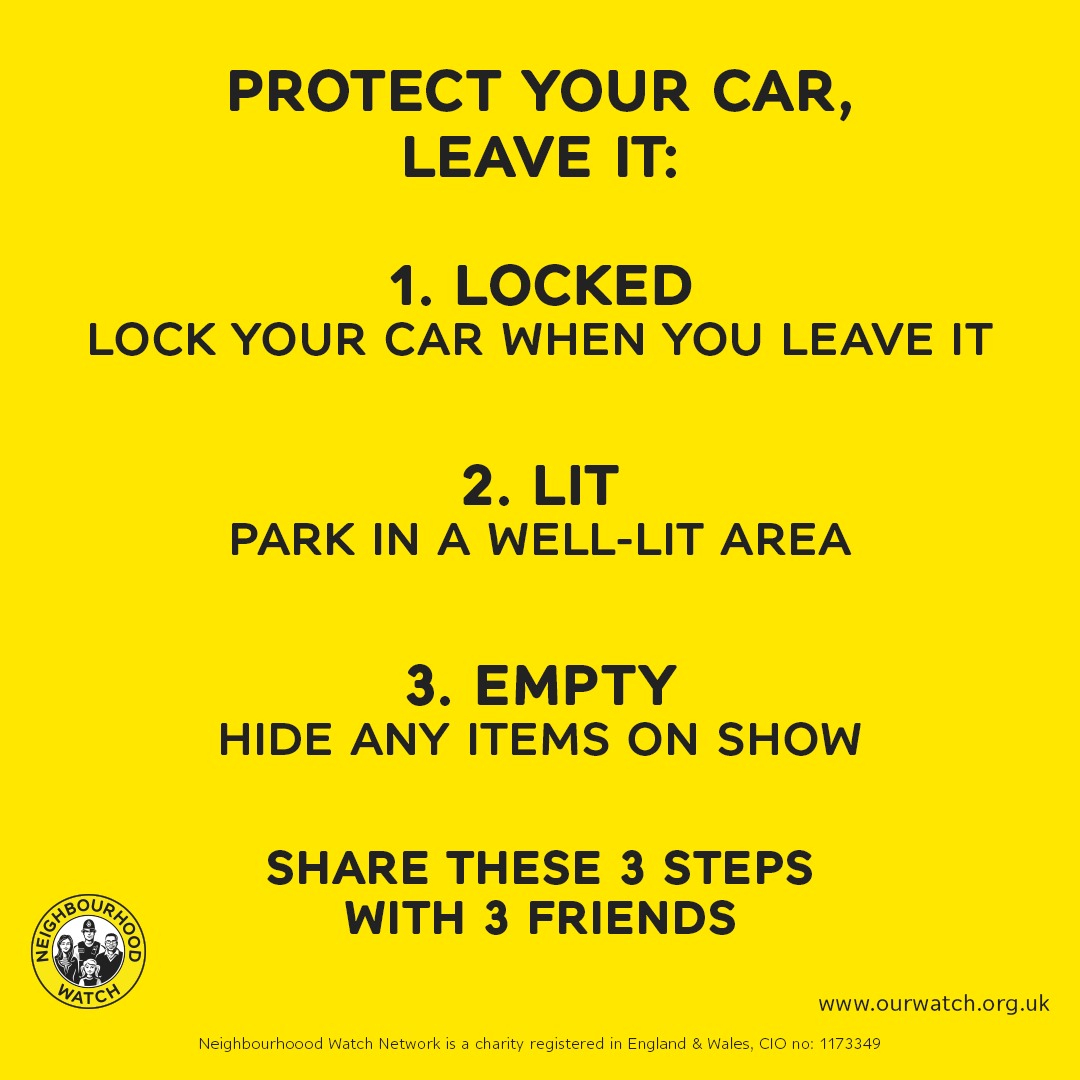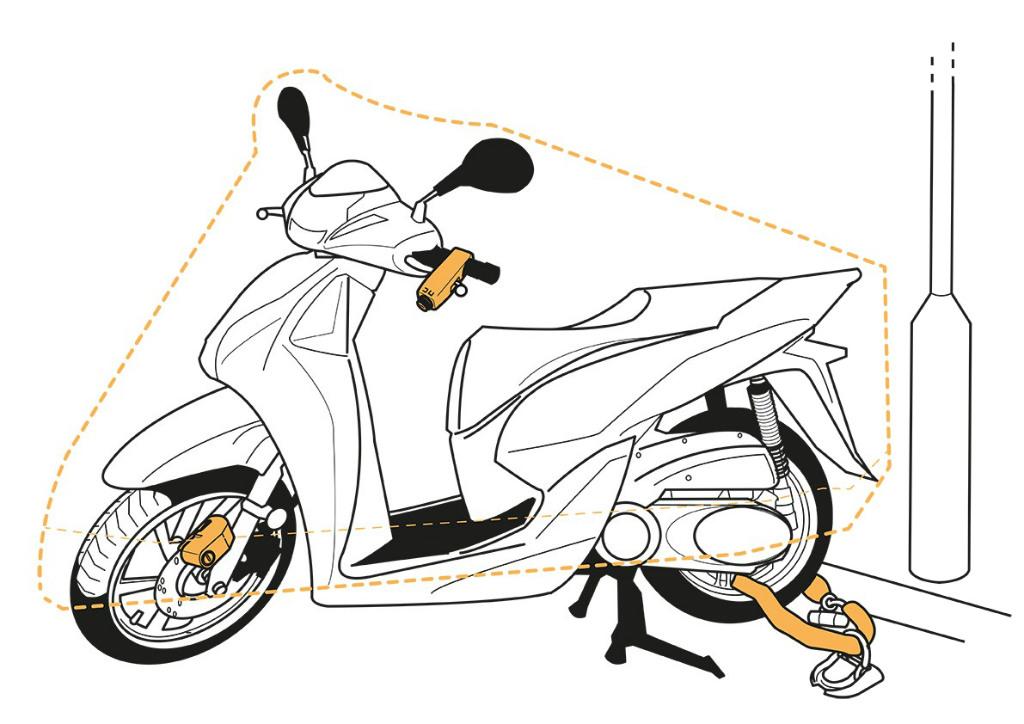Did you know, that in the UK, a car is stolen on average every ten minutes (ITV, 2020)? Whilst we can't always prevent it there are simple steps we can all take to reduce our chances of becoming a victim of car crime.
- Leave your car locked
A simple mistake that can prove calamitous: 44% of cars were broken into via an unlocked door.
- Leave your car well-lit
80% of car crime occurs during the evening or at night. Parking near street lamps or in a busy area can deter thieves.
- Leave your car empty
Owners often forget that personal belongings within the car are at as much risk of being stolen as the car itself.
See our PROTECT YOUR CAR flyer.

TOP TIPS TO KEEP YOUR CAR SAFE
Following 3 simple steps (leave your car locked, well-lit, and empty) will help to keep your car safe, but there are further steps you could take:
- Store car ownership information at home, not in your car
- Secure number plates with anti-theft screws available from car accessory stores
- Keep your car keys out of sight in your home
- Use a Sold Secure soldsecure.com approved anti-theft device on your car. You can search for suppliers on securedbydesign.com
- When parking in a car park, look for a ‘Park Mark’ parkmark.co.uk indicating the car park meets recognised security levels
- Fit locking, anti-tamper wheel nuts to secure alloy wheels
- Secure items outside of your vehicle. Anything left on roof-racks, tailgate racks, holiday top boxes or in tool chests are easily stolen when the vehicle is parked. The use of cable locks, padlocks and self-locking tools chests, which are secured to the vehicle, makes them more secure, but still, don’t leave things in them if you can avoid it.
Car thieves are opportunists. Leaving an iPad on a car seat or forgetting to lock your car can act as an invitation for crime. We want to instil the habit of double-checking where and how you’ve parked with our three simple steps. As a local charity with a trusted voice in the community, we’re asking everyone to proactively support their neighbours and friends by sharing our three steps with three others. By spreading the word, we’re confident we can crackdown on car crime which can be deeply distressing and debilitating for its victims.
John Hayward-Cripps, CEO of Neighbourhood Watch Network
__________________________________
CATALYTIC CONVERTER THEFT
Catalytic converters are targeted because of the precious metals that they are made with, namely rhodium, platinum and palladium. Thieves simply cut the catalytic converter from the exhaust pipe of a parked car and sell them on to scrap metal dealers. Taller vehicles are more vulnerable as the catalytic converters are easier to access.
To reduce the risk of having your catalytic converter stolen you could
- Purchase anti-theft products such as Catloc - a Sold Secure approved product (find out more about Catloc's Secured by Design’s Police Preferred Specification here)
- Park to restrict access to the underneath of the car
- Ask your dealer to weld the catalytic converter to the car
- Fit a tilt alarm
- Register your converter and mark it with a forensic marker, which will make it harder for thieves to dispose of
For more information on catalytic converter theft, have a look at this BBC One Inside Out Catalytic Converter Theft video from March 2020.
__________________________________
KEYLESS CAR THEFT
Keyless car theft – also known as relay theft – is relatively simple. With a relay amplifier and a relay transmitter, a thief can detect whether the car has keyless entry. Working in pairs they identify a house with a car parked nearby and one person stands by the car with a transmitter, while a second waves an amplifier around the perimeter of the house. If the car key is close enough the amplifier will detect its signal, amplify it, and send it to the accomplice’s transmitter.
This transmitter then effectively becomes the key, and tricks the car into thinking the real key is nearby. The thieves can then open the car, get in and drive away.
The whole process can take as little as 60 seconds and can be completed in near silence.
TOP TIPS TO AVOID KEYLESS THEFT
To avoid keyless car theft remember DISTANCE, SIGNAL, STEERING WHEEL.
- KEEP KEYS A SAFE DISTANCE FROM THE CAR: Keeping keys far away from doors and windows. This will minimise the chances a thief will be able to find and amplify the key’s signal and is general good practice.
- BLOCK OR TURN OFF THE SIGNAL: Consider purchasing a Faraday pouch to keep your car key in. These pouches contain signal-blocking materials that stop your key transmitting its code, preventing crooks from being able to detect and amplify the signal. Check your manual or speak to your dealer to find out if your key can be switched off
- STEERING WHEEL LOCK: Consider using a steering wheel lock, a driveway parking post, or even a wheel clamp
For more information and further tips look at this 'Keyless could be Carless' information sheet from West Yorkshire Police.
__________________________________
PROTECT YOUR MOTORCYCLE, MOPED or SCOOTER
To protect you motorcycle, moped or scooter remember LOCK, CHAIN, COVER.
- LOCK: use a disc lock to help secure the front brake disc, or a grip lock to secure the brake and throttle controls. You could also use a D lock on the front wheel to stop it being wheeled away.
- CHAIN: Use a chain lock through the back wheel (the front wheel can be removed). Chain your bike to something heavy, even when in a garage. You can fit specific attachments to lock your bike to at home.
- COVER: Thieves often ‘shop’ for particular bike models. Using a cover instantly makes it less attractive to them. A cover also provides another time consuming obstacle for the thief.
For more information on LOCK, CHAIN, COVER see the Protect your motorcycle page from Met Police.

Further tips
- Set its alarm if it has one
- Use a designated motorcycle parking place with a stand and security loop if you can
- Mark your motorbike with its vehicle identification number
- Add a ‘kill switch’ which prevents the start button from working unless pressed
- Never leave loose items such as helmets or other possessions with your bike
__________________________________
Did you know... Blue Light Aware is a resource containing short videos and animations, produced on behalf of the emergency services. Their crews rely on the help of other road users when they’re on a ‘blue light’ journey. By taking the time to watch Blue Light Aware you will better understand the needs of emergency drivers, reducing the risks you face; while contributing to a safer road environment. You may also be helping to save a life!
__________________________________
If you have been unlucky enough to be a victim of car crime, see our steps on how to report a crime.
To run a PROTECT YOUR CAR campaign locally visit our PROTECT YOUR CAR campaign page.
